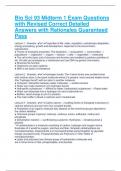Bio Sci 93 Midterm 1 Exam Questions
with Revised Correct Detailed
Answers with Rationales Guaranteed
Pass
Lecture 1 - Answers -✔✔ ● Properties of life: order, regulation, evolutionary adaptation,
energy processing, growth and development, response to the environment,
reproduction.
● Theme of emergent properties: The biosphere → ecosystems → communities →
populations → organisms → organs → tissues → cells → organelles → molecules
● The cell is the basic unit of structure and function and smallest to perform activities of
life. All cells are enclosed by a membrane and use DNA as genetic information.
● Structure fits function
● Organisms as open systems
● DNA is the basis of inheritance
Lecture 2 - Answers -✔✔ ● Hydrogen bonds: The H atom forms one covalent bond
with another atom in the same molecule where it is present, and a second weaker bond
(the "hydrogen bond") with an atom in another molecule
● Cohesion: interaction between water molecules → surface tension
● Water can make maximum of 4 hydrogen bonds.
● Hydrophilic substances → Affinity for water, hydrophobic substances → Repel water
● Water can dissociate into a hydrogen ion and a hydroxide ion.
● Buffers: resist change in pH of a solution
● The main buffer in blood is carbonic acid / bicarbonate
Lecture 3 - Answers -✔✔ ● Carbon atoms → building blocks of biological molecules (4
valence electrons and can form four covalent bonds)
● Properties of an organic molecule also depend on the chemical groups attached to
the carbon skeleton.
● Chemical groups: hydroxyl, carbonyl, carboxyl, amino, sulfhydryl, methyl and
phosphate
● Dehydration reaction → synthesizing a polymer, Hydrolysis → breaking down a
polymer
* A carbohydrate is a molecule consisting of carbon, hydrogen and oxygen atoms.
Examples of it would be sugars, starches and fiber. Simplest carbohydrates are
monosaccharides. Disaccharide is 2 monosaccharides joined together by glyosidic
linkage (covalent bond). Polysaccharides are Polymers of 100s-1000s of
monosaccharides.
● Lipids (not polymers) are diverse group of hydrophobic molecules and
are in three forms of fats, phospholipids, and steroids.
,● Fats → saturated fats vs unsaturated fats, Phospholipids → glycerol + two fatty acids
+ phosphate group + choline, Steroids → Carbon skeleton with 4 rings and varying
functional groups
Lecture 4 - Answers -✔✔ ● Amino acids (monomers) → polypeptides (polymer of
amino acids in specific sequence) → proteins (one or more polypeptides with specific 3-
D conformation)
● Proteins are all structured from the same set of 20 amino acids.
● Structure of an amino acid contains: amino group, hydrogen, carboxyl group and an R
group (variable side chain). Make sure you can identify the polar amino acids vs non
polar amino acids based on their structures.
● Protein folding: - Primary (amino acid sequence) - Secondary
(hydrogen bonding, Alpha helix vs Beta pleated sheets) - Tertiary structure (overall
shape of polypeptide, R group interactions) - Quaternary structure (Overall protein
structure resulting from combined polypeptides of 2 or more, stabilized by R group
interactions)
● A single change in the primary structure of a protein can have pleiotropic effects such
as different disease or health conditions (ex. Sickle cell anemia)
● Damaged or misfolded proteins are actively degraded by proteasome
Lecture 5 - Answers -✔✔ ● Plasma membrane composition: - Lipids (phospholipids
which are the main fabric of membrane that form the bilayer) - Cholesterol (regulates
membrane fluidity) -Proteins (embedded in bilayer and control the movement of different
materials inside and outside of the cell) -Carbohydrates (present on extracellular
surface and are mainly responsible
for cell-cell recognition).
● Fluid mosaic model of plasma membrane
● The cell membrane is fluid.
Lecture 6 - Answers -✔✔ ● Plasma membrane is selectively permeable
○ Can pass through: small, uncharged, nonpolar molecules
○ Cannot pass through: large, charged, polar molecules
● Tonicity
○ Describes the state of the cell based on extracellular environments
○ Hypotonic, isotonic, hypertonic
● Membrane Proteins
○ Carrier proteins: can change shape when a molecule binds to it (active and passive
transport)
○ Channel proteins: opens to allow molecules to pass through (passive)
● Co-Transport
○ Na+/glucose pump (animals)
○ H+/sucrose pump (plants)
● Modes of bulk transport
○ Exocytosis, endocytosis
■ Phagocytosis
, ■ pinocytosis
■ receptor-mediated endocytosis
Lecture 7 - Answers -✔✔ Microfilaments:
Composed of: actin
Plays a role in phagocytosis via
pseudopodia extension
Functions: Maintains cell
shape, transport of cargo over
short distances, cell motility,
cytoplasmic streaming,
contraction of muscle (uses
myosin and ATP)
Intermediate Filaments:
Composed of: many different
types of IF, depending on the
cell type
Very stable
Functions: Forms nuclear
lamina, maintains cell shape
Microtubules:
Composed of: tubulin
Kinesins and dyneins (know
which direction they move!)
Requires ATP for movement
Functions: Movement across
long distances
Lecture 8 - Answers -✔✔ ● Ribosomes
○ Role: synthesize proteins
○ Free ribosomes (float in cytoplasm): synthesize cytosolic proteins
○ Bound ribosomes (on rough ER) : integral membrane proteins & secreted proteins
● Lysosomes
○ Digest food particles, recycle organelles, destroy bacteria
● Endoplasmic Reticulum
○ Connected to the nuclear envelope




